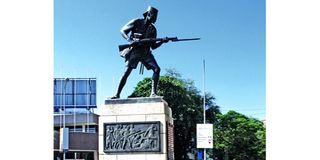Why the iconic Askari Monument in Dar shall not die

What you need to know:
- Dar es Salaam, a bustling city of six million inhabitants does not have many monuments. It needs them. The few ones, like the Askari Monument and the Botanical Gardens, that exist should be well-preserved, even in the wake of urban modernization undertakings.
The Askari Monument is, without doubt, the most famous monument in the city of Dar es Salaam. In view of the construction works going on, to extend the highways for the Bus Rapid Transport (BRT) project, there was concern about the future of the famous monument, but the government made an assurance that the “Askari Monument shall not die”, paraphrasing the title of the book Serengeti Shall Not Die by Michael Grzimek, an account of the work by the book’s author and his son, in making a census of the animals in the Serengeti and life on the Maasai Mara as well.
A monument has been defined as a structure built in a public place to celebrate an important person or event. Monuments are used to honour achievements, or a historic event that happened in the past and respect for people who have achieved great things.
A longer definition sees a monument as a type of structure that is explicitly created to commemorate a person or event, or which has become relevant to a social group as part of their remembrance of historic times or cultural heritage, due to its artistic, historical, political technical or architectural importance.
A monument can also be a place of historical importance such as an old building. So buildings like old churches are major monuments especially in Europe (much as many are currently, not put to their original use). The State House in Dar can be considered to be a monument.
Cities are living entities with a history that may date many years back. A liveable city is one that appreciates its history through monuments, buildings, gardens and parks, streets, neighbourhoods.
But preserving historical heritages is challenging: Natural wear and tear; changes in technology, social values; high land values inviting investors in “modernity” threatened the existence of this heritage. Today however, many countries, make efforts to preserve their cultural heritage.
The Askari Monument was erected in honour of the African soldiers (known as the Kings’ African Riffles – KAR), as well as soldiers who carried loads for the soldiers in the battlefield, known as Carrier Corps. Where the Askari stands however, was another statue of the German Governor in German East Africa, Herman von Wissman. It had been erected earlier, in 1911.
When in 1916, British forces occupied Dar es Salaam, the statue of von Wissman was removed, and in its place, was erected the Askari Monument that still stands to date. We are therefore talking of a statue which is over 100 years old.
The Askari Monument is a bronze sculpture of an African Soldier cast in the United Kingdom by British Sculptor, James Alexander Stevenson. The soldier has a rifle with a bayonet pointed towards the Dar es Salaam Harbor. It stands on a stone pedestal. On its narrow sides is a dedication in Swahili (Arabic and Latin Script) and in English. On the wide sides are two pictorial plaques showing fighting African soldiers and Carrier Corps. Von Wissman’s statue was taken to Germany, but due to agitation by those opposed to depicting people connected with colonialism as heroes, it is now stored in a secret place.
This tells us that monuments can be important for some community, but not for others. They can be accepted during a certain era, and get discredited or destroyed during another. For example, recent years have seen the removal of many monuments of personalities associated with promoting slavery in the US, in the wake of the Black Lives matter movement.
The Askari Monument is one of three other monuments also called Askari. These are to be found in Kenya, in the coastal town of Mombasa, and in the capital city Nairobi.
Why preserved monuments?
They are an important part of the national cultural heritage. Besides, well-preserved historical buildings, monuments and spaces can be economic assets, when they attract visitors especially tourists, who are usually attracted to unique places, and many times, they want to see what may have happened in the past, as well as appreciate the local values.
These visitors pay money to see such attractions. They also pay to use local facilities such as hotels and restaurants, transport. This generates local employment and brings in revenue
Dar es Salaam, a bustling city of six million inhabitants does not have many monuments. It needs them. The few ones, like the Askari Monument and the Botanical Gardens, that exist should be well-preserved, even in the wake of urban modernization undertakings.




